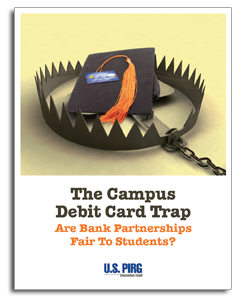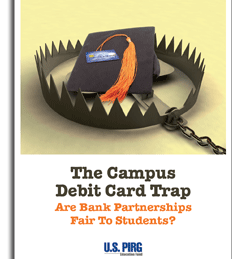Campus card financial service providers take issue with PIRG Report
 Researchers lump products, providers together missing the mark
Researchers lump products, providers together missing the mark
As campuses have embraced electronic distribution of financial aid and banking services tied to campus cards, have students been forced to pay more for the convenience? The U.S. PIRG Education Fund says ‘yes,’ suggesting that college students have been unfairly targeted for extra fees to the financial benefit of both banks and universities.
In a June 2012 report entitled “The Campus Debit Card Trap: Are Bank Partnerships Fair to Students?” the U.S. PIRG asserts that university and bank partnerships to offer financial products to students are unfair and should be curtailed. The researchers explore both student ID cards and student loan disbursements that are tied to a bank account, debit card or reloadable prepaid card.
The report states that nearly 900 schools with more than nine million students nationwide have partnerships with banks or other financial firms. These include 32 of the 50 largest public four-year universities, 26 of the 50 largest community colleges and six of the 20 largest private not-for-profit schools. In total, these banking partnerships reach 42% of the student population.
Though the U.S. PIRG contends that universities and financial services companies make a lot of money from these partnerships, not all parties agree.
Most financial institutions working with campus card programs describe long-term relationship building with young, soon-to-be professionals as the driver for these programs. Short-term profit windfalls simply don’t exist, according to representatives from these institutions.
Wells Fargo has relationships with 40 colleges and universities across the country and views college partnerships as a way to teach new users about financial services products. “[We] are being introduced to students, many of who are looking for their first financial institution. We serve their needs, and hopefully they’ll be lifelong customers and build healthy financial habits,” says Richele J. Messick, spokesperson for Wells Fargo.
Most of Wells Fargo’s university partnerships are connected to student ID card services rather than dedicated exclusively to financial aid delivery.
The U.S. PIRG report states that when student ID services become connected to financial options such as open-loop debit cards, it “may mean that a bank/financial aid firm has taken over the process of issuing IDs at the school.”
Wells Fargo contends that this is not the reality of the relationship and that the banking aspect of a student ID is optional. “The student is the one who has the choice,” says Messick. “You don’t have to link a campus ID to a Wells Fargo account.” When the student opts not to turn on the banking feature of an ID, the ID card still contains all the other campus services, but it just doesn’t also function as a debit card.
PIRG’s focus on fees
The main crux of the U.S. PIRG report focuses around fees related to these types of cards as well as debit cards related to student loan disbursements. The report says that universities are increasingly moving to debit cards as a way to give students their loan money, but by using cards as a form of disbursement, students are at risk of incurring fees.
PIRG sees this as a problem when the dollars in question comes from taxpayer-provided grants and federal loans. U.S. PIRG says this money is designed to go to lower income students who can’t afford the fees tied to these accounts.
For a federally funded student loan to be disbursed via a payment card, the Department of Education stipulates that this is possible “as long as the issuing bank provides conveniently located fee-free ATMs.”
The U.S. PIRG report contends that “convenient” and “fee-free” ATMs still cause problems when lines get too long or cash runs out.
It cites that Higher One, a financial aid disbursement firm with agreements at around 520 schools, has 600 ATMs in service. At peak disbursement times, students queue up in long lines to access their money free of charge, and demand can be greater than the supply of money, forcing some to incur fees of up to $5 because they end up using out-of-network ATMs to get their loan funds.
In the case of Higher One’s ATM position, Shoba Lemoine, spokesperson for Higher One, points out that the company’s debit card isn’t the only disbursement option for students. “Once a school contracts with Higher One to help it disburse refunds to its undergraduate population, the students work with Higher One to select how they want their refund.”
With a Higher One account, students may have their refunds sent to them in one of three ways: direct deposit via ACH to any bank of their choice, a paper check by mail or into an optional Higher One OneAccount checking account. “They must actively choose to open this account,” says Lemoine.
“It is absolutely the student’s choice how they want to receive their refund and they will never be charged to receive it, per Title IV requirements. They can also change their preference at any time at no cost to them. This simply gives the student more choice in how they receive their refunds from their school.”
Lemoine says that a student has the option to choose to open a OneAccount FDIC insured checking account for their loan disbursement. Higher One offers this account through its banking partner, and it has no monthly fee and no minimum balance. Students must activate the account themselves and opt to have the loan money deposited into the account. “Approximately 50 percent of students do not choose to open a OneAccount to have their refunds deposited there,” says Lemoine.
In contrast to the report’s portrayal of the students waiting 50 deep in line at a single fee-free ATM on a campus, most providers boast large ATM networks to support student accounts. U.S. Bank has 23,000 ATMs across the country, Wells Fargo has more than 12,000, and both Blackboard and Sallie Mae offer more than 43,000 surcharge-free ATMs via membership in the Allpoint Network.
Blackboard, a long time player in the closed-loop off-campus market with their BbOne offering, launched their financial aid delivery product called BlackboardPay in 2010. The company’s more recent entry gave them a different perspective on financial aid delivery, says Jeff Staples, vice president of market development for Blackboard.
“We committed to deliver a product that best helped students gain access to their Title IV funds,” says Staples. “We looked at the market and asked how we could best serve both the campus and the student … and not at the expense of one over the other.”
Blackboard points to the prepaid platforms from Money Network and Discover as “new tools” they were able to call upon in the creation of the BlackboardPay. These tools provide features they say are not typically found in older debit solutions. According to Staples, BlackboardPay doesn’t charge a PIN debit fee, there is no possibility of overdraft and there are no minimum balance or monthly service fees for active cardholders. Students can access the funds at no cost at more than 7 million Discover merchants, any of the more than 43,000 surcharge-free Allpoint ATMs and via the Money Network Check to any payee including free check-cashing privileges at more than 3,800 Wal-Marts nationwide.
“Seeking technical compliance with Title IV with a few hundred ATMs isn’t really the same as serving the students’ needs with more than 40,000 ATMs plus ATMs deployed on campus,” Staples said.”We think the campus and students deserve the best offering and fee schedule available, not something that’s simply better than average.”
Perception of mandatory participation
Compelling students to opt for these branded debit cards is another unfair practice, cites the U.S. PIRG report because it opens up students, “already vulnerable as consumers in this area,” to the risk of incurring extra fees, such as hefty overdraft fees and PIN swipe fees.
This may be a young student’s first experience with a financial institution, and the report says that confusing fee structures for these accounts can cost students a lot of money in “hidden” fees.
Most providers of these services take offense to the concept that fees are hidden. Virtually all providers list fees online and provide documentation of fees at multiple points in the process. Financial accounts, like other services, are not free and have fees associated with them. Even “fee-free” accounts have fees for out-of-the-norm activities or improper usage.
“Higher One is not a bank, so cannot speak for those banks named and examined in the study, but Higher One’s offerings do adhere to the fundamental principles discussed by U.S. PIRG in its study, including: 1) providing students with choices, 2) being transparent about how accounts are structured, and 3) enabling colleges and universities to comply with the Department of Education’s standing regulations as they relate to the electronic disbursement of Title IV funds to students,” says Miles Lasater, COO of Higher One in an e-mail statement.
The unfair fees described in the U.S. PIRG’s report are not unlike fees paid by traditional consumers for traditional banking accounts. Virtually all accounts charge for using foreign ATMs and for overdrafting an account. Many banks also charge traditional customers monthly fees for checking accounts. Some banks mitigate those fees for students by offering them accounts with lower fees than the institution’s traditional checking account.
At $3 a month, Wells Fargo’s college checking account is less than its next cheapest account, Value Checking, which costs $9 a month, or $7 for online only statements. Other checking packages that combine savings and debit can cost $12 a month, or $10 for online only statements. The college account includes many benefits of other checking packages, such as checking, savings, a debit card, online bill pay, mobile banking and text account alerts. “Our college offer is a great deal for college students. It’s designed with them in mind,” says Messick.
Higher One’s entry-level checking account has no minimum balance requirements and no monthly fees. It doesn’t require a background check. “Many students find this appealing,” says Lemoine.
Higher One OneAccount customers get a Debit MasterCard, which has a 50-cent fee for PIN-based transactions. “We encourage students to choose free signature-based transactions at the point of sale because they are protected with the MasterCard Zero Liability policy against fraudulent purchases and they are more cost-effective for Higher One. So this fee is avoidable and many students never incur it,” says Lemoine.
Still it is this fee that has caused a great deal of the negative attention to the Higher One offering, and some suggest this has led to the harsh view on student financial account products in general.
“We know that the last thing that a student needs to do is to accumulate more debt,” says Lasater. “We therefore provide financial literacy programs and options so that students can learn how to avoid incurring any fees at all. In short, when it comes to the $1 trillion in student debt that is currently outstanding, we look to be part of the solution in helping students manage their money wisely.”
Prepaid takes lumps from PIRG
General purpose reloadable (GPR) cards, commonly called prepaid cards, are a rapidly growing product for campus card and financial aid delivery applications. According to the Federal Reserve, they are also the fastest growing electronic payment method in the U.S. The PIRG reports takes a harsh view of prepaid citing the lack of government regulation and protections.
Describing the prepaid card industry as unregulated, the report cites “no real consumer protections by federal law” and “no protections to limit your liability.”
To the contrary however, bank-issued prepaid products are often treated with the same protections as other payment offerings. Several issuers of prepaid products mentioned in the report, suggest that painting prepaid cards with such as broad stroke is irresponsible and misleading. According to one provider, “it is true that prepaid industry is not regulated in the same way as credit and debit, but as a bank, all our prepaid users are protected in the same way as other card customers.”
Prepaid debit offers great tools as long as the platform is designed with the consumer in mind, says Blackboard’s Staples. “BlackboardPay accounts are FDIC insured and feature an extremely compelling fee schedule,” he adds. “It is a very consumer-friendly iteration of prepaid debit.”
Report’s accuracy questioned
A number of parties – service providers, campuses, associations and publications – have both publicly and privately called into question the accuracy of the PIRG report. Perhaps the most frequently heard compliant was that the report seems to lump all student-facing financial services together. According to a statement issued by the National Association of College and University Business Officers, “the U.S. PIRG report conflates the student aid refund process with debit-linked college and university campus cards.”
In reality, these are very different products. They are marketed differently to students, entered into with different drivers from the institution’s perspective, and priced differently for users.
NACUBO goes on to say the report, “fails to adequately recognize that students have a choice in deciding where and how to manage personal banking and financial transactions and that campus cards are offered by campuses for service, convenience, and security.”
It is difficult to argue that efforts to contain tuition costs require the streamlining of administrative services. This is the fundamental reason that campuses first began to explore electronic delivery of financial aid. According to NACUBO, “the (PIRG) report misleads readers to believe that campuses profit by providing electronic refunds of student financial aid dollars.” Most interviewed for this article agreed that cost savings can be achieved via these services. But they stressed that few campuses create new revenue streams.
Watching the fallout
Despite the questions surrounding the report’s accuracy, it has already spawned dozens of media reports, legislative rumblings and at least one lawsuit.
U.S. Sen. Dick Durbin, D-Ill., said he “will be working in Washington to put an end to the unreasonable practices highlighted in this (PIRG) report.” The measures he intends to take were not specified in Dubin’s press release.
A lawsuit has been filed, and timing makes it appear to be at least in part a result of the report. A California resident and college student claims financial services provider Higher One “deceptively assessed bank fees” and that the “plaintiff and other Higher One account holders nationwide, were deceived into using a Higher One account in order to access their college financial aid money…then subsequently charged unfair and improperly disclosed bank fees.”
This is not the first time student-facing financial services have come under fire. Most agree it will not be the last. For many professionals that live and breathe these services on a daily basis, it is just unfortunate that some well-intended researchers missed the mark on a number of very fundamental concepts … creating the current stir.




